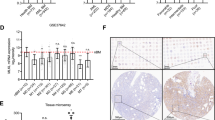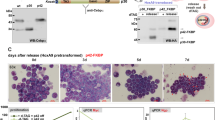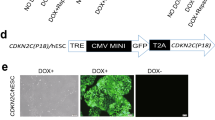Abstract
The Notch family of transmembrane receptors has been implicated in the regulation of many developmental processes. In this study, we evaluated the role of Notch4 in immature hematopoietic progenitors by inducing, with retroviral transduction, enforced expression of Int-3, the oncogenic and constitutively active form of mouse Notch4. Int-3-transduced human myeloid leukemia (HL-60) cells demonstrated significantly delayed expression of differentiation markers following retinoic acid and 12-0-tetradecanoylphorbol 13-acetate treatment. Furthermore, HL-60 cells expressing Int-3 displayed a slower growth rate than cells infected with void virus, and accumulation in the G0/G1 phases of cell cycle. Transduction with deletion mutants of Int-3 defined the importance of individual domains of the protein (in particular, the ANK domain and the C-terminal domain) in the inhibition of differentiation and growth arrest of HL-60 cells. When mouse bone marrow enriched for stem cells (5-fluorouracil-resistant, lineage negative) was transduced and cultured for two weeks, the Int-3-transduced population displayed a lower expression of differentiation markers and a three- to five-fold higher frequency of colony-forming cells (CFU-GM/BFU-E) than control cultures. These results strongly support the notion that Notch signaling inhibits differentiation and promotes expansion of hematopoietic stem/progenitor cells.
This is a preview of subscription content, access via your institution
Access options
Subscribe to this journal
Receive 12 print issues and online access
$259.00 per year
only $21.58 per issue
Buy this article
- Purchase on Springer Link
- Instant access to full article PDF
Prices may be subject to local taxes which are calculated during checkout







Similar content being viewed by others
References
Artavanis-Tsakonas S, Rand MD, Lake RJ . Notch signaling cell fate control and signal integration in development. Science 1999; 284: 770–776.
Mumm JS, Kopan R . Notch signaling: from the outside in. Dev Biol 2000; 228: 151–165.
De Strooper B, Annaert W, Cupers P, Saftig P, Craessaerts K, Mumm JS et al. A presenilin-1-dependent gamma-secretase-like protease mediates release of Notch intracellular domain. Nature 1999; 398: 518–522.
Schroeter EH, Kisslinger JA, Kopan R . Notch-1 signalling requires ligand-induced proteolytic release of intracellular domain. Nature 1998; 393: 382–386.
Moore MAS, Han W, Ye Q . Notch signaling during hematopoiesis. In: L Zon (ed). Hematopoiesis: A Developmental Approach. New York: Oxford University Press, 2001, pp 323–336.
Ohishi K, Katayama N, Shiku H, Varnum-Finney B, Bernstein ID . Notch signalling in hematopoiesis. Semin Cell Dev Biol 2003; 14: 143–150.
Pear WS, Radtke F . Notch signaling in lymphopoiesis. Semin Immunol 2003; 15: 69–79.
Ellisen LW, Bird J, West DC, Soreng AL, Reynolds TC, Smith SD et al. TAN-1, the human homolog of the Drosophila notch gene, is broken by chromosomal translocations in T lymphoblastic neoplasms. Cell 1991; 66: 649–661.
Karanu FN, Murdoch B, Miyabayashi T, Ohno M, Koremoto M, Gallacher L et al. Human homologues of Delta-1 and Delta-4 function as mitogenic regulators of primitive human hematopoietic cells. Blood 2001; 97: 1960–1967.
Varnum-Finney B, Purton LE, Yu M, Brashem-Stein C, Flowers D, Staats S et al. The Notch ligand, Jagged-1, influences the development of primitive hematopoietic precursor cells. Blood 1998; 91: 4084–4091.
Kojika S, Griffin JD . Notch receptors and hematopoiesis. Exp Hematol 2001; 29: 1041–1052.
Bellavia D, Campese AF, Alesse E, Vacca A, Felli MP, Balestri A et al. Constitutive activation of NF-kappaB and T-cell leukemia/lymphoma in Notch3 transgenic mice. EMBO J 2000; 19: 3337–3348.
Singh N, Phillips RA, Iscove NN, Egan SE . Expression of notch receptors, notch ligands, and Fringe genes in hematopoiesis. Exp Hematol 2000; 28: 527–534.
Han W, Ye Q, Moore MA . A soluble form of human Delta-like-1 inhibits differentiation of hematopoietic progenitor cells. Blood 2000; 95: 1616–1625.
Karanu FN, Murdoch B, Gallacher L, Wu DM, Koremoto M, Sakano S et al. The notch ligand jagged-1 represents a novel growth factor of human hematopoietic stem cells. J Exp Med 2000; 192: 1365–1372.
Li L, Milner LA, Deng Y, Iwata M, Banta A, Graf L et al. The human homolog of rat Jagged1 expressed by marrow stroma inhibits differentiation of 32D cells through interaction with Notch1. Immunity 1998; 8: 43–55.
Jones P, May G, Healy L, Brown J, Hoyne G, Delassus S et al. Stromal expression of Jagged 1 promotes colony formation by fetal hematopoietic progenitor cells. Blood 1998; 92: 1505–1511.
Walker L, Carlson A, Tan-Pertel HT, Weinmaster G, Gasson J . The notch receptor and its ligands are selectively expressed during hematopoietic development in the mouse. Stem Cells 2001; 19: 543–552.
Nomaguchi K, Suzu S, Yamada M, Hayasawa H, Motoyoshi K . Expression of Jagged1 gene in macrophages and its regulation by hematopoietic growth factors. Exp Hematol 2001; 29: 850–855.
Parreira L, Neves H, Simoes S . Notch and lymphopoiesis: a view from the microenvironment. Semin Immunol 2003; 15: 81–89.
Carlesso N, Aster JC, Sklar J, Scadden DT . Notch1-induced delay of human hematopoietic progenitor cell differentiation is associated with altered cell cycle kinetics. Blood 1999; 93: 838–848.
Tsai S, Fero J, Bartelmez S . Mouse Jagged2 is differentially expressed in hematopoietic progenitors and endothelial cells and promotes the survival and proliferation of hematopoietic progenitors by direct cell-to-cell contact. Blood 2000; 96: 950–957.
Varnum-Finney B, Brashem-Stein C, Bernstein ID . Combined effects of Notch signaling and cytokines induce a multiple log increase in precursors with lymphoid and myeloid reconstituting ability. Blood 2003; 101: 1784–1789.
Ohishi K, Varnum-Finney B, Bernstein ID . Delta-1 enhances marrow and thymus repopulating ability of human CD34(+)CD38(−) cord blood cells. J Clin Invest 2002; 110: 1165–1174.
Pear WS, Aster JC, Scott ML, Hasserjian RP, Soffer B, Sklar J et al. Exclusive development of T cell neoplasms in mice transplanted with bone marrow expressing activated Notch alleles. J Exp Med 1996; 183: 2283–2291.
Aster JC, Xu L, Karnell FG, Patriub V, Pui JC, Pear WS . Essential roles for ankyrin repeat and transactivation domains in induction of T-cell leukemia by notch1. Mol Cell Biol 2000; 20: 7505–7515.
Varnum-Finney B, Xu L, Brashem-Stein C, Nourigat C, Flowers D, Bakkour S et al. Pluripotent, cytokine-dependent, hematopoietic stem cells are immortalized by constitutive Notch1 signaling. Nat Med 2000; 6: 1278–1281.
Stier S, Cheng T, Dombkowski D, Carlesso N, Scadden DT . Notch1 activation increases hematopoietic stem cell self-renewal in vivo and favors lymphoid over myeloid lineage outcome. Blood 2002; 99: 2369–2378.
Lam LT, Ronchini C, Norton J, Capobianco AJ, Bresnick EH . Suppression of erythroid but not megakaryocytic differentiation of human K562 erythroleukemic cells by Notch-1. J Biol Chem 2000; 275: 19676–19684.
Milner LA, Bigas A, Kopan R, Brashem-Stein C, Bernstein ID, Martin DI . Inhibition of granulocytic differentiation by mNotch1. Proc Natl Acad Sci USA 1996; 93: 13014–13019.
Uyttendaele H, Marazzi G, Wu G, Yan Q, Sassoon D, Kitajewski J . Notch4/int-3, a mammary proto-oncogene, is an endothelial cell-specific mammalian Notch gene. Genes Dev 1996; 122: 2251–2259.
Gallahan D, Callahan R . The mouse mammary tumor associated gene INT3 is a unique member of the NOTCH gene family (NOTCH4). Oncogene 1997; 14: 1883–1890.
Robbins J, Blondel BJ, Gallahan D, Callahan R . Mouse mammary tumor gene int-3: a member of the notch gene family transforms mammary epithelial cells. J Virol 1992; 66: 2594–2599.
Jhappan C, Gallahan D, Stahle C, Chu E, Smith GH, Merlino G et al. Expression of an activated Notch-related int-3 transgene interferes with cell differentiation and induces neoplastic transformation in mammary and salivary glands. Genes Dev 1992; 6: 345–355.
Uyttendaele H, Soriano JV, Montesano R, Kitajewski J . Notch4 and Wnt-1 proteins function to regulate branching morphogenesis of mammary epithelial cells in an opposing fashion. Dev Biol 1998; 196: 204–217.
Soriano JV, Uyttendaele H, Kitajewski J, Montesano R . Expression of an activated Notch4(int-3) oncoprotein disrupts morphogenesis and induces an invasive phenotype in mammary epithelial cells in vitro. Int J Cancer 2000; 86: 652–659.
Hsieh JJ, Henkel T, Salmon P, Robey E, Peterson MG, Hayward SD . Truncated mammalian Notch1 activates CBF1/RBPJk-repressed genes by a mechanism resembling that of Epstein–Barr virus EBNA2. Mol Cell Biol 1996; 16: 952–959.
Kato H, Sakai T, Tamura K, Minoguchi S, Shirayoshi Y, Hamada Y et al. Functional conservation of mouse Notch receptor family members. FEBS Lett 1996; 395: 221–224.
Hsieh JJ, Nofziger DE, Weinmaster G, Hayward SD . Epstein–Barr virus immortalization: Notch2 interacts with CBF1 and blocks differentiation. J Virol 1997; 71: 1938–1945.
Shawber C, Nofziger D, Hsieh JJ, Lindsell C, Bogler O, Hayward D et al. Notch signaling inhibits muscle cell differentiation through a CBF1-independent pathway. Development 1996; 122: 3765–3773.
Buron MI, Rodriguez-Aguilera JC, Gonzalez-Reyes JA, Villalba JM, Alcain FJ, Navarro F et al. A quantitative ultrastructural and cytochemical study of TPA-induced differentiation in HL-60 cells. Leukemia Res 1993; 17: 863–872.
Milner LA, Kopan R, Martin DI, Bernstein ID . A human homologue of the Drosophila developmental gene, Notch, is expressed in CD34+ hematopoietic precursors. Blood 1994; 83: 2057–2062.
Bigas A, Martin DI, Milner LA . Notch1 and Notch2 inhibit myeloid differentiation in response to different cytokines. Mol Cell Biol 1998; 18: 2324–2333.
Ingles-Esteve J, Espinosa L, Milner LA, Caelles C, Bigas A . Phosphorylation of Ser2078 modulates the Notch2 function in 32D cell differentiation. J Biol Chem 2001; 276: 44873–44880.
Schroeder T, Just U . Notch signalling via RBP-J promotes myeloid differentiation. EMBO J 2000; 19: 2558–2568.
Tan-Pertel HT, Walker L, Browning D, Miyamoto A, Weinmaster G, Gasson JC . Notch signaling enhances survival and alters differentiation of 32D myeloblasts. J Immunol 2000; 165: 4428–4436.
Schroeder T, Just U . mNotch1 signaling reduces proliferation of myeloid progenitor cells by altering cell-cycle kinetics. Exp Hematol 2000; 28: 1206–1213.
Sriuranpong V, Borges MW, Ravi RK, Arnold DR, Nelkin BD, Baylin SB et al. Notch signaling induces cell cycle arrest in small cell lung cancer cells. Cancer Res 2001; 61: 3200–3205.
Morimura T, Goitsuka R, Zhang Y, Saito I, Reth M, Kitamura D . Cell cycle arrest and apoptosis induced by Notch1 in B cells. J Biol Chem 2000; 275: 36523–36531.
Johnston LA, Edgar BA . Wingless and Notch regulate cell-cycle arrest in the developing Drosophila wing. Nature 1998; 394: 82–84.
Tamura K, Taniguchi Y, Minoguchi S, Sakai T, Tun T, Furukawa T et al. Physical interaction between a novel domain of the receptor Notch and the transcription factor RBP-J kappa/Su(H). Curr Biol 1995; 5: 1416–1423.
Krebs LT, Xue Y, Norton CR, Shutter JR, Maguire M, Sundberg JP et al. Notch signaling is essential for vascular morphogenesis in mice. Genes Dev 2000; 14: 1343–1352.
Li L, Huang GM, Banta AB, Deng Y, Smith T, Dong P et al. Cloning, characterization, and the complete 56.8-kilobase DNA sequence of the human Notch4 gene. Genomics 1998; 51: 45–58.
Leong KG, Hu X, Li L, Noseda M, Larrivee B, Hull C et al. Activated Notch4 inhibits angiogenesis: role of beta1-integrin activation. Mol Cell Biol 2002; 22: 2830–2841.
Uyttendaele H, Closson V, Wu G, Roux F, Weinmaster G, Kitajewski J . Notch4 and jagged-1 induce microvessel differentiation of rat brain endothelial cells. Microvasc Res 2000; 60: 91–103.
Shutter JR, Scully S, Fan W, Richards WC, Kitajewski J, Deblandre GA et al. Dll4, a novel Notch ligand expressed in arterial endothelium. Genes Dev 2000; 14: 1313–1318.
Kumano K, Chiba S, Kunisato A, Sata M, Saito T, Nakagami-Yamaguchi E et al. A Notch1 but not Notch2 is essential for generating hematopoietic stem cells from endothelial cells. Immunity 2003; 18: 699–711.
Phillips RL, Ernst RE, Brunk B, Ivanova N, Mahan MA, Deanehan JK et al. The genetic program of hematopoietic stem cells. Science 2000; 288: 1635–1640.
Ivanova NB, Dimos JT, Schaniel C, Hackney JA, Moore KA, Lemischka IR . A stem cell molecular signature. Science 2002; 298: 601–604.
Park I-K, He Y, Lin F, Laerum OD, Tian Q, Bumgarner R et al. Differential gene expression profiling of adult murine hematopoietic stem cells. Blood 2002; 99: 488–498.
Akashi K, He X, Chen J, Iwasaki H, Niu C, Steenhard B et al. Transcriptional accessibility for genes of multiple tissues and hematopoietic lineages is hierarchically controlled during early hematopoiesis. Blood 2003; 101: 383–390.
Karanu FN, Yuefei L, Gallacher L, Sakano S, Bhatia M . Differential responses of primitive human CD34− and CD34+ hematopoietic cells to the Notch ligand Jagged-1. Leukemia 2003; 17: 1366–1374.
Hicks C, Johnson SH, diSibio G, Collazo A, Vogt TF, Weinmaster G . Fringe differentially modulates Jagged1 and Delta1 signalling through Notch1 and Notch2. Nat Cell Biol 2000; 2: 515–520.
Acknowledgements
We wish to thank Kate deBeer for her secretarial assistance in preparation of this manuscript. This work was supported by NIH Grant HL61401 and NCI Grant PO1CA59350 (to MASM) and CNR Biotechnology Programme (to GM).
Author information
Authors and Affiliations
Corresponding author
Rights and permissions
About this article
Cite this article
Ye, Q., Shieh, JH., Morrone, G. et al. Expression of constitutively active Notch4 (Int-3) modulates myeloid proliferation and differentiation and promotes expansion of hematopoietic progenitors. Leukemia 18, 777–787 (2004). https://doi.org/10.1038/sj.leu.2403291
Received:
Accepted:
Published:
Issue Date:
DOI: https://doi.org/10.1038/sj.leu.2403291
Keywords
This article is cited by
-
All-trans retinoic acid enhances, and a pan-RAR antagonist counteracts, the stem cell promoting activity of EVI1 in acute myeloid leukemia
Cell Death & Disease (2019)
-
Dissecting the retinoid‐induced differentiation of F9 embryonal stem cells by integrative genomics
Molecular Systems Biology (2011)
-
Notch signaling in pediatric malignancies
Current Oncology Reports (2008)
-
Expression of DLK1 in hematopoietic cells results in inhibition of differentiation and proliferation
Oncogene (2005)
-
Fbxw7/Cdc4 is a p53-dependent, haploinsufficient tumour suppressor gene
Nature (2004)



